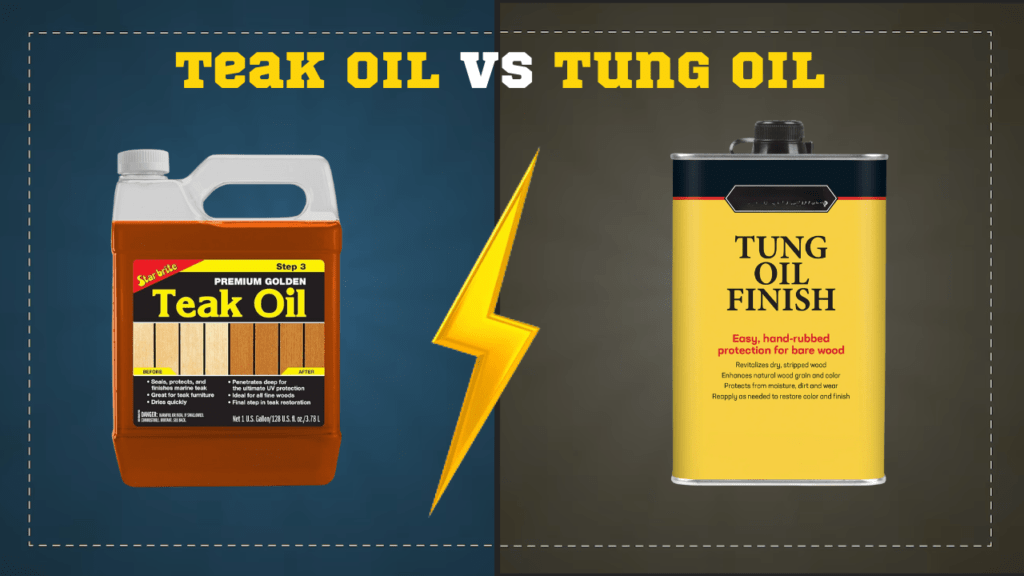
Wood finishing oils are one of the best ways to protect, beautify and prolong the life of furniture, countertops or any wood piece throughout your home. The two preferred options are teak oil and tung oil. Both have distinct advantages, but they’re not the same — and selecting the wrong one for your project could impact everything.
In this detailed resource, I’m going to explain it all as clearly as possible by comparing teak oil vs tung oil—what each of them is, how teak oil works, what tung oil does, the benefits and drawbacks of both options, and the most important differences you’ll need to know if you want to finish wood.
What Is Teak Oil?
In spite of the name, teak oil is not made from teak wood. Instead, it’s a hybrid product, usually a mixture of linseed oil or tung oil combined with varnishes, resins, and mineral spirits. It is formulated to sink into hardwoods such as teaks, mahoganies, and rosewoods; providing the durability and protection exotic wood needs.
- Purpose: Enhances wood grain, protects against drying and cracking and provides a moderate UV and water resistance.
- Drying Time: You can expect it to dry within 8–12 hours, which is perfect for quick projects.
- Best For: Outdoor furniture, boats, hardwood tables, and decorative wooden items.
The main drawback here is maintenance — teak oil requires periodic reapplication (every few months outdoors) to keep it in protective shape.
What Is Tung Oil?
Tung oil is a natural drying oil obtained by pressing the seed from the nut of the tung tree (Vernicia fordii). It has been used for over 2,500 years, particularly in China, for waterproofing and wood finishing.
Unlike the teak oil, it’s not blended with the synthetic additives if purchased in its pure form.
- Purpose: It penetrates deep into the wood fibers, and it cures into a hard, water-resistant layer, and gives a warm, matte finish.
- Drying Time: Much slower — every coat will individually take 24–48 hours, and you will need multiple coats.
- Best For: Butcher blocks, countertops, cutting boards, fine furniture, and antique restoration.
The main benefit of tung oil is that it’s non-toxic and food safe once fully cured, so it’s great for surfaces that come into contact with food.
Teak Oil vs Tung Oil: Head-to-Head Comparison
Here’s how the two finishes stack up against each other:
| Feature | Teak Oil | Tung Oil |
| Composition | Blend of linseed/tung oil, varnishes, and solvents | Pure oil from tung tree seeds (if 100% pure) |
| Drying Time | Fast (8–12 hours per coat) | Slow (24–48 hours per coat) |
| Durability | Hard finish, scratch-resistant, but needs reapplying | Long-lasting, strong water and alcohol resistance |
| Appearance | Darkens porous woods; enhances warm tones | Natural matte look, keeps original wood color |
| Water Resistance | Good, but not the best | Excellent—especially in humid or wet environments |
| Toxicity | May contain chemicals depending on brand | Safe and eco-friendly once fully cured |
| Maintenance | Needs regular upkeep | Requires fewer reapplications once built up |
| Ease of Use | Quick and easy to apply | More labor-intensive with multiple coats |
| Price | Around $20 for 16 oz | Around $20 for 16 oz |
Pros and Cons of Teak Oil
Pros
- Quick drying time
- Scratch-resistant finish
- Easy to apply and reapply
- Enhances rich color tones in hardwoods
Cons
- Not pure—often contains additives
- Can darken lighter woods more than desired
- Requires frequent maintenance, especially outdoors
- May not be food-safe
Pros and Cons of Tung Oil
Pros
- 100%pure naturally occurring and doesn’t have any toxic side effects.
- Exceptional water and alcohol resistance
- Long-lasting finish with fewer reapplications
- Food-safe once cured
- Preserves natural wood color
Cons
- Slow drying—can take days to finish a project
- Needs multiple coats (often 4–6)
- May be difficult to apply without streaking
- More expensive than blended oils
Which Oil Should You Choose?
The decision comes down to your project and priorities:
Choose Teak Oil if:
- You need a fast-drying oil for outdoor furniture.
- Your project includes dense hardwoods such as teak or mahogany.
- You want a finish that can take some scratching, but are okay with the idea of reapplying it somewhat frequently.
Choose Tung Oil if:
- You prefer a natural and a eco-friendly option.
- You’re finishing cutting boards, countertops, or surfaces that comes in contact with the food.
- You want maximum water resistance and durability.
- You don’t mind taking more time for application.
Application Tips for Best Results
How to Apply Teak Oil
- Clean the wood surface thoroughly.
- Apply the oil thoroughly by a clean cloth or brush in a thin layer.
- Allow to sit for 10–15 minutes, then wipe excess away.
- Let dry 8-12 hours and apply two coats of paint.
- Reapplying every few months is recommended for outdoor use.
How to Apply Tung Oil
- Smooth the wood by sanding it down and then dust.
- Apply a thin layer of it to the wood with a cloth and rub it in along the grain.
- Leave it on for 30 minutes and then wipe off any excess.
- Wait 24–48 hours between coats.
- Layer on 4-6 coats for full coverage.
FAQs About Teak Oil vs Tung Oil
1. Can I use teak oil on teak wood?
Surprisingly, it’s not recommended. Teak tree oil may contain additives that teak’s oils do not react well to, or may themselves be mixed with other substances, which leads to mildew or makes it dry unevenly.
2. Is tung oil completely waterproof?
Tung oil is relatively water resistant, but no finish will guarantee 100% water proof. Best performance is obtained by multiple coats.
3. Which oil is better for outdoor furniture?
Teak oil is also commonly used for furniture intended for use outside, as it is very easy to apply and dries in a reasonable amount of time. But tung oil can have a long life if applied properly.
4. Is teak oil safe for food contact?
Generally, no. Because they contain additives and solvents, so it’s not recommended that you use them on cutting boards or other kitchen surfaces.
5. Can I mix teak oil and tung oil?
Some products already contain both. But when it comes to your home, it’s always best to pick one finish and stick with it for consistency and predictability.
Final Thoughts
When choosing between teak oil vs tung oil, there is no one right answer. If you want the ease of application and scratch protection on any hardwood furniture (including patio), teak oil is your friend. Alternatively, Tung oil is the solution if you want a natural and hard-wearing finish that is food safe.
By choosing the right oil for your project, not only you will protect whatever furniture or accessory you are working on, but also ensure that it looks its best – whether preserving a weathered teak bench or putting the final touches on a handcrafted butcher block.

